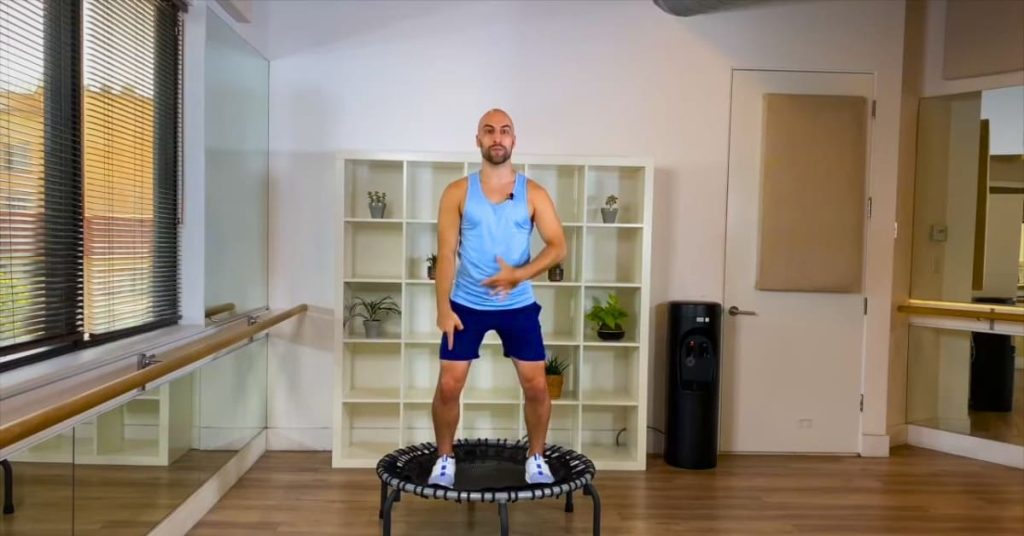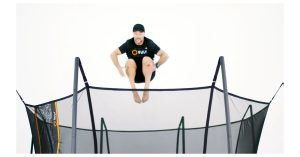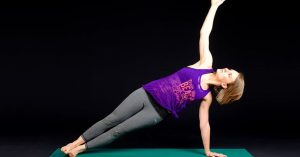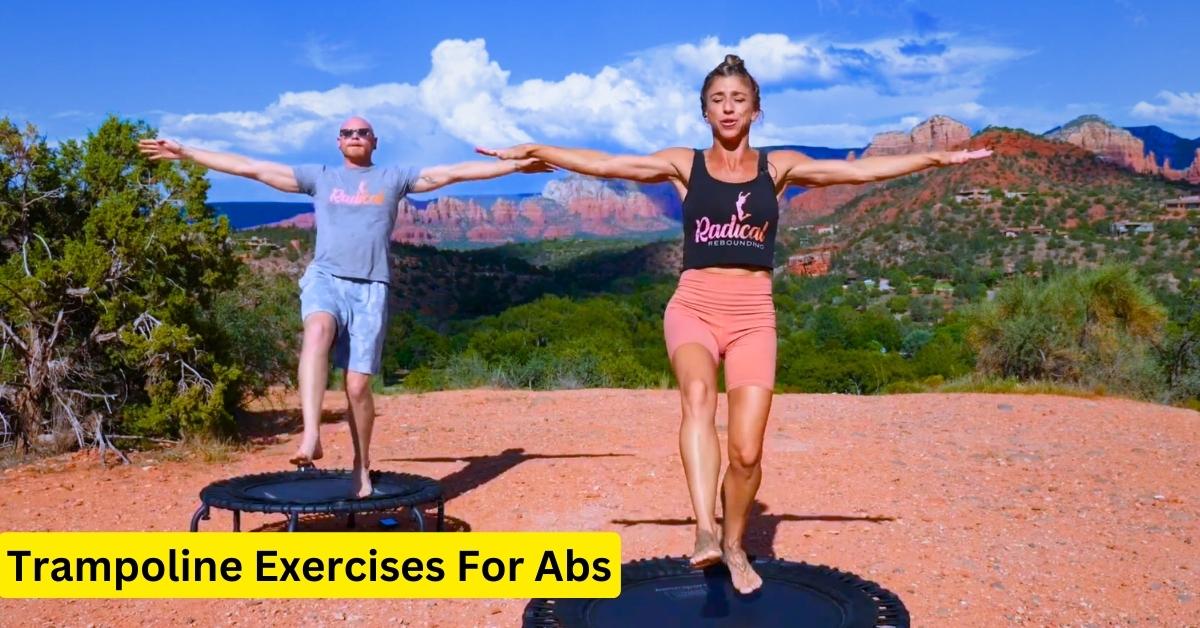Get ready to bounce your way to killer abs! Discover the fun and effective trampoline exercises for abs that will sculpt your core like never before.
Are you tired of doing the same old crunches and sit-ups to work your abs? Well, we have an exciting and effective solution for you – trampoline exercises for abs!
Jumping on a trampoline not only provides a fun and exhilarating workout, but it also targets your core muscles in a unique way. By incorporating exercises like jumping jacks, crunches, plank bounces, knee tucks, Russian twists, scissor kicks, side planks with leg lifts, and bicycle crunches into your trampoline routine, you can achieve stronger and more defined abs.
These exercises engage your abdominal muscles while also challenging your balance and stability. Plus, the added bounce from the trampoline intensifies the workout even further.
So get ready to jumpstart your ab routine with these dynamic trampoline exercises that will leave you feeling energized and motivated to reach new fitness heights!
Trampoline Exercises For Abs: Trampoline exercises for abs include tuck jumps, pike jumps, knee lifts, and seated bounce twists. These exercises engage the core muscles, helping to strengthen and tone the abdominal area while enjoying a fun and dynamic workout.
Warm Up with Jumping Jacks

Now, let’s get your abs warmed up with some jumping jacks! You’ll feel the burn and get those muscles ready for an intense trampoline workout. Jumping jacks are a fantastic warm-up exercise that not only targets your abs but also engages your entire body.
They increase your heart rate and improve blood circulation, warming up your muscles and preparing them for the upcoming trampoline exercises.
Jumping jacks have several benefits as a warm-up exercise. Firstly, they help to loosen up tight muscles and joints, reducing the risk of injury during your trampoline workout.
Secondly, they activate multiple muscle groups simultaneously, including your abs, arms, legs, and core. This full-body engagement boosts calorie burn and stimulates fat loss in the abdominal area.
If you’re looking for alternatives to jumping jacks for a warm-up, there are a few options you can consider. High knees are one such alternative that effectively warms up the abs while enhancing cardiovascular endurance.
Another option is jogging in place or doing butt kicks to get your heart rate up before starting the trampoline exercises.
Remember to always listen to your body and choose a warm-up exercise that suits you best. Now that you’re aware of the benefits of jumping jacks as a warm-up and some alternative options, it’s time to incorporate them into your routine and make sure those abs are ready for an amazing trampoline workout!
Crunches on the Trampoline
To really work those core muscles, try out crunches on the bouncy surface of a trampoline! Trampoline crunches are an excellent way to engage your abs and take your workout to the next level. Not only do they target your abdominal muscles, but they also provide a fun and challenging exercise experience.
Here are some benefits of incorporating trampoline crunches into your routine:
- Increased stability: The unstable surface of the trampoline forces your core muscles to work harder to maintain balance, strengthening them in the process.
- Improved coordination: Trampoline crunches require coordination between your upper and lower body, helping enhance overall body control.
- Enhanced calorie burn: The bouncing motion adds an element of cardio to your ab workout, increasing the number of calories burned.
- Reduced impact on joints: Compared to traditional floor crunches, trampoline crunches have less impact on joints, making them a safer option for individuals with joint pain or injuries.
- Fun and enjoyable: Working out on a trampoline adds an element of playfulness and enjoyment to your exercise routine.
There are several variations you can try with trampoline crunches to keep things interesting. You can experiment with different arm positions or add twists for extra oblique engagement. Remember to engage your core throughout each rep and breathe consistently.
So hop on that trampoline and get ready for an exhilarating ab workout!
Plank Bounces
Get ready to take your core workout up a notch with plank bounces, an intense and dynamic exercise that’ll challenge your entire body!
Plank bounces on the trampoline are a great way to engage your abs while also getting in some cardio. To properly engage your abs during this exercise, get into a plank position on the trampoline.
Make sure your hands are directly under your shoulders and your body’s in a straight line from head to toe.
From here, you can begin by gently bouncing up and down using your core strength. This motion activates not only your abdominal muscles but also other muscles in your body, making it a great full-body workout.
For advanced trampoline workouts, there are variations of plank bounces you can try. One variation’s the single-leg bounce, where you lift one leg off the trampoline while maintaining the plank position with the other leg.
Another variation’s the side-to-side bounce, where you shift your weight from one hand to the other as you bounce sideways on the trampoline.
Remember to always listen to your body and start with easier variations before progressing to more advanced moves. Incorporating plank bounces into your trampoline routine help strengthen and tone not only your abs but also other muscle groups throughout your body.
So get ready for a challenging yet rewarding workout that’ll leave you feeling stronger and more energized!
Knee Tucks

Engage your entire body and challenge yourself with knee tucks, a dynamic exercise that’ll leave you feeling stronger and more energized.
Knee tucks on a trampoline are an excellent way to work your abs and improve your core strength. Here are some key benefits of adding knee tucks to your workout routine:
- Increased abdominal strength: By lifting your knees towards your chest while maintaining balance on the trampoline, you engage multiple muscles in your core, including the rectus abdominis and obliques. This exercise helps develop a strong midsection.
- Improved balance and coordination: Performing knee tucks requires stability and control as you jump and bring your knees up. Over time, this exercise can enhance your overall balance and coordination skills.
Alternatives to knee tucks:
- Plank jacks: Start in a high plank position with hands directly under the shoulders. Jump both feet out wide like a jumping jack, then jump them back together.
- Mountain climbers: Begin in a high plank position, then alternate bringing each knee towards the chest as if running in place.
Incorporating knee tucks into your trampoline workout routine not only targets your abs but also provides an effective full-body workout experience. Challenge yourself today with this exercise and enjoy the numerous benefits it offers!
Chair Exercises
You can do seated exercises on the rebounder that target your deep abdominal muscles. To begin, sit upright on the rebounder with your knees bent and feet flat on the floor. Tighten your tummy muscles and gently bounce up and down.
If you can keep your upper body steady while bouncing, it means your core muscles are working. For more of a challenge, try lifting one foot at a time while you bounce. Another exercise you can try is the choo-choo train.
Sit up straight with your legs extended and feet off the floor. Use your butt muscles to slide your body forward and backward, and you’ll feel your side muscles working too.
Russian Twists
Russian twists are an exciting and challenging way to work your core and enhance your overall fitness level. This exercise targets the muscles in your abs, obliques, and lower back, helping to improve your core strength and stability.
By incorporating Russian twists into your trampoline workout routine, you can take your ab exercises to the next level.
To perform Russian twists on a trampoline, start by sitting on the edge of the trampoline with your knees bent and feet flat on the mat. Lean back slightly while maintaining good posture and balance.
Lift your feet off the ground so that you’re balancing on your tailbone. From this position, twist your torso from side to side, touching the ground on each side with both hands.
Doing Russian twists regularly can provide several benefits for core strength. It helps to strengthen the rectus abdominis (six-pack muscles), internal and external obliques, transverse abdominis (deep core muscles), as well as lower back muscles. Additionally, it improves spinal mobility and stability.
To make this exercise more challenging, you can hold a medicine ball or dumbbell in front of you while twisting or extending your legs out straight instead of keeping them bent.
Incorporating Russian twists into your trampoline workout routine will not only target your abs but also add variety to keep you motivated. Remember to maintain proper form throughout each rep for maximum effectiveness and safety. Keep pushing yourself, knowing that every twist brings you closer to a stronger core!
Classic Exercises
The edge of the rebounder has a softer surface compared to exercising on the hard floor. In rebounding classes, instructors move straight into working on the abdomen by doing exercises on the rebounder.
The bouncy and slightly unstable surface adds a bit of a balance challenge during exercises like regular crunches, reverse curls (lifting your pelvis with your feet up toward the ceiling), oblique curls, and plank exercises.
These exercises are suitable for people who may find stability ball crunches and other advanced core exercises too difficult due to balance issues.
Mountain Climbers
Twist your body in a fast and controlled motion, bringing one knee towards your chest while extending the other leg behind you, as if you’re climbing a steep mountain. Mountain climbers are an excellent exercise for building core strength and toning your abs.
They engage multiple muscle groups such as your abdominals, obliques, hip flexors, and shoulders, making it a great total body workout.
One of the key benefits of mountain climbers is that they target your core muscles effectively. By constantly engaging and stabilizing your abs throughout the exercise, you’ll strengthen and define your midsection. This can lead to improved posture, better balance, and reduced risk of lower back pain.
If you’re new to mountain climbers or find them too challenging at first, there are modifications you can make to ease into the exercise. Start by placing your hands on an elevated surface like a bench or step instead of the floor.
This will decrease the angle of your body and reduce the pressure on your wrists while still allowing you to work on engaging your core.
Remember to maintain proper form throughout: keep your hips level with your shoulders, avoid sagging or arching in the lower back, and breathe deeply throughout each repetition.
Keep practicing this exercise regularly to build strength in your abs and enjoy all its benefits for overall fitness.
Scissor Kicks
Doing scissor kicks is a fantastic way to work your core and tone up your midsection while also feeling the burn in your legs. This exercise targets your abs, specifically the rectus abdominis, and obliques, helping you achieve those defined abs you’ve always wanted.
Scissor kicks are also great for improving hip flexibility and overall lower body strength.
One of the benefits of scissor kicks is that they can be done anywhere and without any equipment. You can easily incorporate them into your home workout routine or add them to your gym session. Plus, they’re suitable for all fitness levels, making them accessible to everyone.
To get the most out of scissor kicks, it’s important to avoid some common mistakes. Firstly, avoid lifting your head or shoulders off the ground as this can strain your neck muscles and take away from targeting your abs. Instead, keep a neutral spine by engaging your core throughout the exercise.
Another mistake to avoid is rushing through the movement. Take it slow and controlled, focusing on proper form rather than speed. By doing so, you’ll maximize muscle engagement and prevent injury.
Incorporating scissor kicks into your workout routine will not only help you strengthen your core but also improve overall stability and balance. So grab a mat or find a comfortable spot on the floor and start reaping these amazing benefits today!
Side Planks with Leg Lifts

Alright, you’ve mastered the scissor kicks and now it’s time to take your trampoline workout to the next level with side planks with leg lifts.
This exercise is a great way to target your abs, obliques, and hips while also improving your balance and stability.
To perform side planks with leg lifts on the trampoline, start by lying on your side with your forearm resting on the trampoline surface. Your elbow should be directly under your shoulder and your legs extended out straight.
Lift your hips off the ground, creating a straight line from head to toe. Engage your core and lift one leg up towards the ceiling, then lower it back down. Repeat this movement for a set number of reps before switching sides.
Side planks are already an effective exercise for strengthening your core, but adding leg lifts takes it up a notch. The elevated surface of the trampoline adds an extra challenge as you have to work harder to stabilize yourself.
Here’s a table that breaks down some modifications you can make to accommodate different fitness levels:
| Fitness Level | Modification |
|---|---|
| Beginner | Fully extend the top leg and add ankle weights |
| Intermediate | Perform side plank without lifting the leg |
| Advanced | Fully extend top leg and add ankle weights |
Incorporating side planks with leg lifts into your trampoline routine will not only help sculpt strong abs but also improve overall core strength and stability. So get ready to feel the burn in all the right places!
Bicycle Crunches
To amp up your trampoline workout, try incorporating bicycle crunches. They are a dynamic and effective exercise that targets the entire core. Bicycle crunches are a great way to engage your abs and strengthen your obliques while also improving balance and coordination.
Here are three variations of bicycle crunches that you can try on the trampoline:
- Alternating Legs: Lie on your back with your hands behind your head. Bring one knee towards your chest while simultaneously twisting your torso to bring the opposite elbow towards the knee. Then switch sides, extending one leg out straight while bringing the other knee towards your chest.
- Double Crunch: Start in the same position as before, but this time bring both knees towards your chest while lifting your shoulders off the trampoline. Hold for a moment at the top before lowering back down.
- Side-to-Side Twist: Lie on your back with both legs extended straight up towards the ceiling. As you twist to one side, reach for the outside of that foot with the opposite hand, engaging both obliques.
Incorporating these bicycle crunch variations into your trampoline workout will not only help sculpt and tone your abs but also improve overall core strength and stability. So hop on that trampoline and give them a try today!
Cool Down and Stretch
After completing your intense trampoline workout, take a moment to cool down and stretch to help relax your muscles and prevent any potential soreness.
Cooling down after exercise is just as important as the actual workout itself. It allows your heart rate to gradually return to normal and helps flush out any metabolic waste that may have accumulated in your muscles.
To cool down effectively, try incorporating some gentle movements such as walking or slow jogging on the trampoline for 5-10 minutes. This will help bring your heart rate down gradually while still keeping you active.
Afterward, focus on stretching the major muscle groups that were engaged during your workout. Stretching has numerous benefits, including increased flexibility and range of motion, improved circulation, and reduced muscle tension. It also helps prevent injury by promoting better posture and alignment.
When stretching, remember to hold each stretch for 15-30 seconds without bouncing or forcing the movement. Some effective stretches for post-trampoline workouts include standing quad stretches, hamstring stretches, calf stretches, chest stretches, and shoulder rolls.
Remember to breathe deeply throughout each stretch to enhance relaxation.
By taking the time to cool down properly and stretch after your trampoline exercises for abs, you’re not only supporting muscle recovery but also improving overall flexibility and preventing potential injuries. So make sure you prioritize this essential part of your fitness routine!
Safety Considerations
Safety considerations are crucial when engaging in trampoline exercises for abs or any other physical activity. Trampolines can be fun and effective, but they also pose some risks if not used properly. Here are some essential safety considerations to keep in mind:
- Warm-Up: Always begin with a proper warm-up to increase blood flow to muscles and reduce the risk of injury. Perform light cardio exercises and dynamic stretches before getting on the trampoline.
- Stable Surface: Ensure that the trampoline is placed on a flat, stable surface and is in good condition without any tears, holes, or damaged springs.
- Safety Equipment: If available, use safety pads to cover the trampoline springs and frame to prevent accidental contact.
- Proper Footwear: Wear appropriate athletic shoes with good traction to provide stability and reduce the risk of slipping.
- Space and Surroundings: Ensure that the area around the trampoline is clear of any obstacles or hazards to avoid collisions or accidents.
- Supervision: If beginners or children are using the trampoline, have a qualified instructor or adult supervise the exercises to ensure proper form and safety.
- Progression: Start with basic exercises and progress gradually to more advanced ones to avoid overexertion and strain on the muscles.
- Listen to Your Body: Pay attention to any discomfort or pain during exercises and stop immediately if you feel unwell or experience any unusual sensations.
- Hydration: Stay hydrated throughout the workout to avoid dehydration and maintain optimal performance.
- Avoid Overcrowding: Limit the number of people on the trampoline at one time to prevent collisions and reduce the risk of injury.
- Personal Health Considerations: If you have any pre-existing medical conditions, consult with a healthcare professional before engaging in trampoline exercises.
- Precautions for Children: Children should always be supervised while using the trampoline and should follow age-appropriate exercises under proper guidance.
Remember, safety should be the top priority when engaging in trampoline exercises. By following these considerations, you can have a fun and effective workout while minimizing the risk of injuries.
Frequently Asked Questions for Trampoline Exercises For Abs:
Q:1 How long should I warm up before starting trampoline exercises?
To maximize the benefits of trampoline exercises and prevent injuries, it’s crucial to warm up properly. Spend at least 5-10 minutes doing dynamic stretches and light cardio to get your heart rate up. This will prepare your body for the various types of trampoline exercises you’ll be doing.
Q:2 Can I do trampoline exercises if I have a back injury?
Trampoline exercises can be beneficial for back injury rehabilitation. Start with gentle movements, such as bouncing lightly on the trampoline while engaging your core muscles. Gradually increase intensity and duration as you progress.
Q:3 Are there any modifications I can do for the trampoline exercises if I have knee pain?
To modify trampoline exercises for knee pain, try low-impact alternatives like walking or swimming. Incorporate knee-strengthening exercises such as leg raises and squats in your routine. Remember to listen to your body and consult a healthcare professional if needed. Keep going, you’ve got this!
Q:4 How many reps and sets should I do for each trampoline exercise?
For each trampoline exercise, aim for 3 sets of 10-15 reps. Start with a number that challenges you but allows proper form. Gradually increase the intensity by adding more reps or sets as you progress. Stay consistent and watch your abs transform!
Q:5 Can trampoline exercises help me lose belly fat?
Incorporate trampoline exercises into your workout routine to maximize belly fat loss. They are more effective than traditional ab workouts as they engage your core muscles while providing a fun and dynamic cardio workout. Let’s get jumping!
Conclusion:
Congratulations on completing these trampoline exercises for abs! You’ve taken a great step towards strengthening and toning your core.
Remember to always warm up before starting any workout, and cool down and stretch afterward to prevent injury.
Consistency is key, so make sure to incorporate these exercises into your regular fitness routine. Keep pushing yourself and stay motivated – you’re well on your way to achieving those strong, defined abs you’ve been working for.
Keep up the great work!
We hope you will be well aware of trampoline exercises for abs, after reading this comprehensive article. If you have any questions, feel free to comment below!

